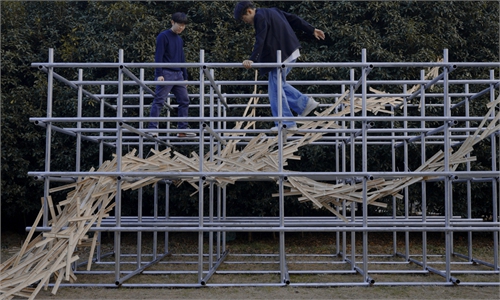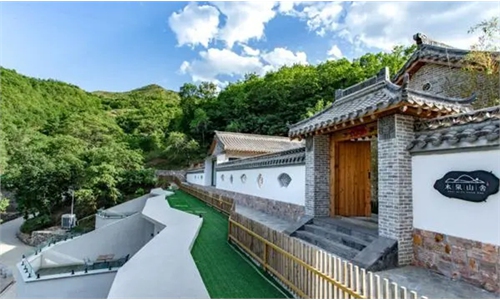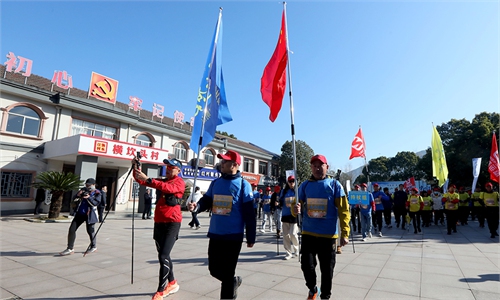ARTS / CULTURE & LEISURE
7 Chinese sites become world-class 'Tourism Villages,' offer chance to explore spiritual life

Graphic: Liu Xiangya/GT
The United Nations World Tourism Organization (UNWTO) has recently named seven villages in China among the world's 55 best "Tourism Villages" of 2024.
What distinguishes tourism villages from other villages?
This question can be answered by looking at UNWTO's criteria such as "healthy, safety and security," as well as a common core standard: whether or not a village "boasts a one-of-a-kind legacy," Zhang Yiwu, a Peking University professor, told the Global Times.
Sites such as Guanyang village in Fujian Province, Xiaogang village in Anhui Province and Azheke village in Honghe Hani and Yi Autonomous Prefecture, Yunnan Province, are sites on the list.
Each of these villages have unique character, for example, the indigenous ethnic minority lifestyle is iconic to Azheke village, whereas Xiaogang village was a leading pioneering site of Chinese rural reformation in the late 1970s.
No matter if it is cultural diversity or modern social progress, these factors define a Chinese village's legacy and also play "major roles for village tourism planning to take shape," Xu Xiaolei, a marketing expert in the tourism industry, told the Global Times.
Capitalizing on their unique character, Chinese villages are drawing up tourist plans that make use of a "combination" tactic.
Take Yandunjiao village in Shandong Province, which is also on list, as an example. The combination of "rural travel and wildlife" allowed the village to bring in more than 500,000 tourists in 2023.
Every year starting in October, nearly 10,000 swans from Siberia, Mongolia and other places come to the village, drawing in tourists. Taking advantage of this natural resource, numerous food, accommodation and entertainment facilities were built to turn the village into a well equipped tourist spot benefiting travelers and the local economy.
Prior to Yandunjiao village being put in the limelight, a rural tourist cluster in Zhejiang Province encompassing the towns of Wuzhen, Xitang and Puyuan have already become successful through the combination of "theater," "Hanfu clothing" and "knitted-ware fashion design." Notably these are all related to culture.
Such a combination shows that niche rural resources can improve tourism. At the same time, this combo has not only revived villages, but also a wider range of rural spaces in towns and counties across the country, allowing cultural narratives to play a major role in progressing rural tourism.
China's village tourism has also been boosted through multi-platform collaboration and policy support.
Since 2023, China's Ministry of Culture and Tourism has guided platforms such as short video platform Douyin, lifestyle platform Xiaohongshu, travel platform Fliggy to co-launch an action plan that focuses on the digital side of rural tourism.
Several promotional activities have been held under this guidance. Campaigns such as "Embracing Spring" and "Explore Autumn in the Mountains" and their related topics have successfully garnered over 10.88 billion views. Such online content has made rural cultural traditions like the "Yingge dance" and "village football" became widespread buzzwords.
"The government's guidance, along with the rich resources inherent in Chinese rural areas, ensures the sustainable development of village tourism in China," Xu said. He also noted that rural tourism in China is no longer just about exploring the countryside, but also exploring a "leisure lifestyle that sustains one's spiritual life."
In recent years, commercial models such as "rural cafes" and art exhibitions at villages have blossomed. These business forms may seem like they are urbanizing Chinese villages, but in reality, they offer new possibilities for Chinese rural tourism to actually become more connected to international visitors, not just domestic visitors.
Featuring stellar international artists such as Thomas Dambo and Stevens Vaughn, Wulong Lanba was an international Earth art fair that was launched in the rural area of Wulong in Chongqing. Focusing on different themes such as architecture, the art of using forest resources, international art and cultural fairs have also blossomed in other villages in the provinces of Hunan, Fujian and Guangdong.
These international events are valuable not only because they become new cultural tourism draws for villages, but also spark curiosity and longing in visitors who have never experienced China's countryside, drawing them in with the promise of unique experiences that blend modernity with traditional rural charm.
Prompted by China's visa-free policy, "China Travel" has become a popular trend among overseas travelers. If visiting metropolis like Beijing and Shanghai can impress visitors with the country's robust modern growth, then visiting Chinese villages can show them the relaxed and authentic side of life in China.
The author is a reporter with the Global Times. life@globaltimes.com.cn



